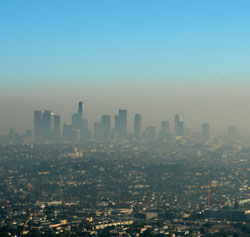
L.A. Smog
There’s good news and there’s bad news to be found in a recent wire-service report that reductions in air pollution have increased the average life-span of Americans.
One aspect of bad news is that the wire-service report, based on an article in the Journal of New England Medicine, is so specific that it stretches belief: “Cleaner air over the past two decades has added nearly five years to the average life expectancy in the United States.” As always, the devil lies in the details. The researchers were not scientists monkeying with test tubes but statisticians trying to prove some conventional wisdom. The pollution in question was only that from particulates, tiny particles in the air from dust, factory and power plant smoke, and diesel-engine exhausts.
The good news is this means that exhausts from California’s and Washington’s favorite whipping boy, the internal combustion engine, were not involved. It also makes it a tougher sell for the mainly import brands planning to re-introduce diesel passenger cars to the U. S. market.
The JNEM report compared particulate pollution in the 1979-83 period with that of 1999-2000, identifying a roughly one-third decline for the 51 metro areas studied. Likewise, deaths from lung cancer and chronic obstructive pulmonary disease (COPD) fell, increasing life expectancy from 74.3 years to 77. Both are important items of good news. The research statisticians went to great lengths to account for the wild cards in such studies: smoking, demographics, ethnicity, etc. The 51 metro areas did not include Detroit, apparently for lack of data, and in a sense that also is good news.
And yet, anyone who has dealt with mortality statistics knows there are problems. Everyone dies of a failed heart. What cause of death goes on the death certificate, generally supplied by the undertaker? Can lung cancer and COPD invariably be blamed on particulate emissions? Suppose the deceased had spent most of their lives elsewhere than the final metro area. What about tobacco smoking, gasoline-engined car exhausts, burning leaves, secondary cigarette smoke, all the usual bugaboos on the activist blame train? True, the Harvard and Brigham Young statisticians who crunched these numbers did their best to “control” for such factors, but there are practical limits because of lacking data.
Let’s not forget that the first control targets of Environmental Protection Agency vehicle regulations more than a generation ago were hydrocarbon, carbon monoxide and oxides of nitrogen emissions—not particulates. Later the EPA took on particulates, which as noted inhibited fuel-efficient diesels. As far as I know, EPA so far has not figured out how to control dust. Still, activists and their Congressional allies invariably blame cars for unhealthy air (ahem, not to mention Global Warming).
Then there’s yet another problem. It seems pretty well accepted nowadays that there has been a large increase in the incidence of asthma—a lung condition–roughly since 1980, and mostly among children in the cleanest countries of Great Britain, Australia, New Zealand and the U. S. Yet how does this square with the statistics showing the one-third reduction in lung-effecting particulates over the same time period?
Mind you, again, these were recently issued statistical studies aimed at proving regulations helped—and they did. But I hold that there is much more for science—not statistical studies–to learn before we can really pin the cause-and-effect tail on the pollution donkey’s true relation to health.
